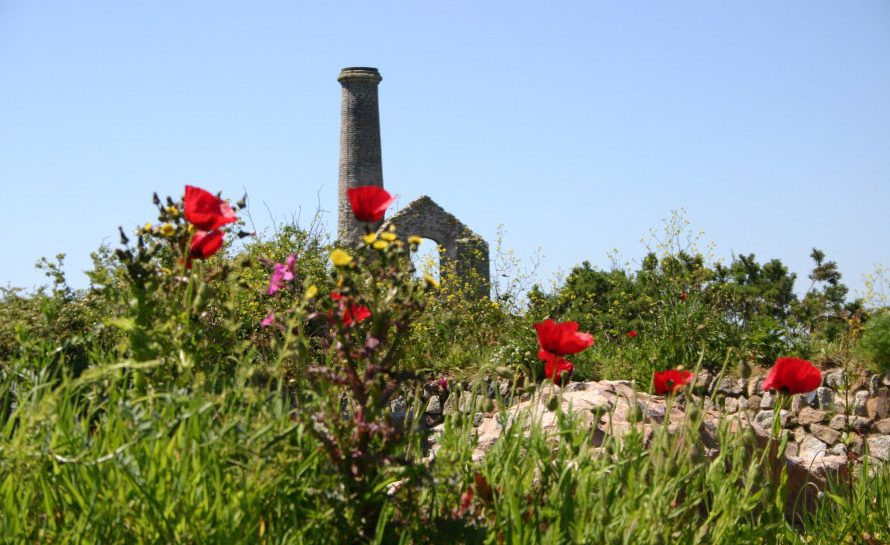
Following his articles about Barripper and Kehelland, David Oates now moves slightly east to introduce us to the third element in his trilogy – Troon.
Set high on a hill above Camborne, Troon is unusual in Cornwall where large villages are not common in the way that they are in other parts of the country. Traditionally, the settlement pattern in Celtic areas has been scattered with small, pastoral communities living in relative isolation. There was no reason in early times for people to gather in large numbers as water sources and food was abundant – they did have defensive points in times of danger but for the most part lived in small groups for much of the time.
Troon, or Trewoon was one of a number of small medieval tenements in the area, along with Laity, Pellutes, Chytodden and Newton, all of which were subsumed by the village when it grew larger and are now place names of farms within the curtilage of the village. Local names like Trevarthen – associated with Laity and the Dennis family with Chytodden are some of the few who can claim antiquity in the area. An interesting note in the parish records gives a little colour to one of these early Troon men in 1705 – William Trevarthen, it says, was “destroid to a hurling with Redruth men on the High Dounes”.
The village grew most dramatically around the turn of the century when Victoria was coming to the end of her reign with those magnificent terraces of miners’ cottages being built first in Pendarves Street, then New Street with later Edwardian additions in Newton road, Laity Road and Treslothan Road. These later more spacious and luxurious homes reflected a growing prosperity for many in the village with a number being built with “mining money” from abroad.
 Original water supply for the miners houses in Pendarves Street
Original water supply for the miners houses in Pendarves Street
Apart from a few groups like the Trevarthen and Dennis families, who lived in the medieval hamlets now absorbed in the village, most of the population moved here from all over Cornwall and West Devon, from where the mining industry was in decline. My family has always professed to be “Troon folk through and through” but a search of the parish register sees my ancestor arriving in the area around 1800, before the village as such existed with many others not evident until the growth of Wheal Grenville Mine. Family anecdotal evidence suggests we were from the St Just area – perhaps at a time when copper was exhausted and tin had not yet come to the fore. The Oates family, though, raised its status somewhat in the middle of the 19th century by marrying into the influential and long established Dennis family whose credentials were impeccable. They were farmers and tradesmen but the Oates family were miners to a man. My great grandfather, Richard Oates, travelled overseas and contracted an illness from which he died in Troon at the age of 42. He was also the first organist at the Wesleyan Chapel, built 1863, when wind instruments were abandoned. A booklet marking the renovation of this chapel in the mid-twentieth century sees old folk still recalling the massive contribution he made to choral music in the village.
Because there were very few extended family structures or social infra-structures in place, the community became very much self-sufficient – in spite of being so near to Camborne (which had developed very quickly, in the same way and at the same time). They found great strength and security in keeping to the old ways and customs and tended to reject and even resent, interference from “outsiders”. This led to them being seen in a similar way by other local communities and Troon folk were often referred to as “downsers” – from a far more basic and rougher environment than others! That self-sufficiency saw some twenty seven shops in Troon when it was at its most prosperous.
 Richard Henry Oates, first organist at Troon Wesley
Richard Henry Oates, first organist at Troon Wesley
The community was entirely dependent on the fortunes of the mine and, to some extent, the whims of the mineral lords such as the Pendarves family, who owned much of the property in Troon. The mine was the great Wheal Grenville, deservedly in the front runners of Cornish mines, highly productive and long-lived, needing a history all of its own to place it properly in the story of Troon. Although within the curtilage of the local aristocratic families such as the local landowners Pendarves and Basset, it was controlled by the Fortescue family of Boconnoc, far removed from Troon. The Pendarves family, though, had a vice-like grip on the land appropriate for development and many Troon folk lived in their properties – a precarious occupation as they were leased under the “three lives” system where the occupier named three people and as long as they lived the occupier still had a home. Enterprising people such as my great grandmother, Elizabeth Oates (neé Dennis) would snap up the leases on numerous houses and then sub-let them.
 Dressing floors, Wheal Grenville Mine
Dressing floors, Wheal Grenville Mine
However, in spite of the influence of the lord of the manor, these new settlers were a resilient lot and quickly established a healthy independence and a necessary social order. Sport was very important; mostly rugby and cricket, and the unwritten rules of conduct were formulated by the Methodist Church – which few dared contradict. Some did, though, and are numbered amongst the real characters the village produced. After a rugby match the players would share a tin bath at the back of the Grenville Arms with the requisite pints of beer. On more than one occasion, suspecting a violation of the licensing laws, the constabulary would arrive and the pints would disappear under the dirty water of the bath!
There was no doubt, though, of the leading role played by the Methodist Church in Troon with the precarious life of the miner, with a high mortality rate, focusing the minds of the population on a spiritual dimension to their existence. The growing population locally led to the creation of new parishes within the old parish of Camborne and one, Treslothan, was clearly for the spiritual care of Troon and Beacon. As in much of Cornwall, though, the Methodist Church was, effectively, the established church with two large buildings on opposite sides of the road in the centre of the village and numerous smaller chapels in local, satellite communities. On one side of the road was the fairly plain, and austere, United Methodist Free Church and on the other side, the more ornate building of the Wesleyans with stained glass!
 The winding engine at South Condurrow Mine
The winding engine at South Condurrow Mine
Throughout the mining district these denominations of the same church reflected a class divide – those slightly up the social scale went to the Wesleyans and the others to the United Methodists
Many miners and Methodists were also Freemasons – something the church centrally would frown upon now – though I don’t think Troon ever had its own lodge.
The main activity of the whole year, even surpassing traditional festivals such as Christmas, was the Midsummer festival or tea treat always held on Midsummer day, the Feast of St John. All work stopped and the chapels would parade around the village, in association with the congregation from the parish church. The parade would take a traditional route, each chapel with its own band leading them. Camborne Band, however, was always the leading band and one of the joys of the year for my grandfather, who was one of the cornet players, to “come home fer tea treat”. My grandmother would say he was never at home, either at work, at the British Legion (as a WW1 veteran) or at the band room. As they reared eight children he must have spent some time in a domestic setting!
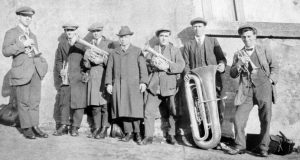 Troon Band, date unknown
Troon Band, date unknown
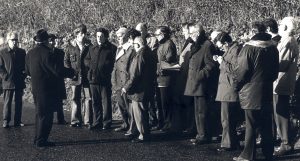 Men of Troon Toc H, taking Cornish carols to the community on Christmas morning c.1970
Men of Troon Toc H, taking Cornish carols to the community on Christmas morning c.1970
The real mystery of tea treat, though was the Serpentine Walk that took place in the Square at the conclusion of the parade and before the distribution of the tea treat buns. No-one seemed to know how it went and there was one man (always a man) in each generation who had the knowledge and who would step out, wearing a grand button hole to lead and make sure the intricate walk went according to plan. Adding to the mystery, it wasn’t always a chapel goer! In the dying days of tea treats a plan was made and should future generations wish to revive it, the basis is there
The ancient roots of this festival, linked to the summer solstice, show customs and cultures overlaying each other – right back to our far pagan past.
 Plan of Serpentine Walk
Plan of Serpentine Walk
 Serpentine Walk circa 1950
Serpentine Walk circa 1950
Several large travelling fairs would visit Troon for the week in which tea treat took place and on the day itself the streets and fields would be packed with stalls and activities. To assess its popularity it was said that in the early 1900s some seven hundred children would parade – mothers, children and miners dressed in their summer finery – all bought for tea treat.
However, in spite of all female finery of tea treat, Troon was very much a male preserve for much of its life as an active mining community. Sport would have been almost exclusively for the men of the community and there was a thriving Liberal Club and a Men’s Institute. In later years it was a stronghold of the Labour Party with “street wardens” appointed to keep the faithful on target! Some of those wardens were known to this writer – stalwarts of the chapel and deserving of the description “Christian Socialists”.
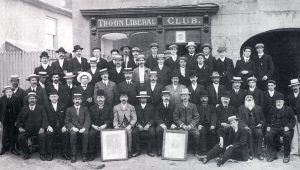 Political activists outside their club in Fore Street
Political activists outside their club in Fore Street
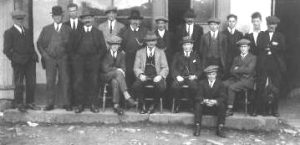 A group outside the Labour Club
A group outside the Labour Club
After the Methodist Church, the school had a considerable influence and the Headmaster of Troon School was a much respected figure – he lived in the community and knew everything that went on there. That went on until the 1960’s – but the world changed, Troon changed and School House was sold.
A real taste of life in this mining community, and the influence exerted by the school, can be seen from these extracts from the school log which highlight the importance of tea treats, not only in Troon but in other localities as well and point to social deprivation in the mining communities:
- June 24th 1904 – We have a half-holiday this afternoon as the Nonconformist Schools are having their annual treats.
- 11th November 1904 – There is to be a holiday on Monday for Camborne Feast.
- M.I’s report for Year ending October 1904
The teachers work with praiseworthy diligence and the school appears to be making real progress in various ways, though some of the lessons might be more successful in sustaining the intelligent interest and individual attention of the Scholars. Greater proficiency is desirable in Reading and Number, and serious efforts should be made to induce the children to express themselves in a more audible manner.
- May 25th 1905 – Half-holiday as many children are attending the Gold and Silver Tree at the Wesley Chapel.
- June 21st 1906 – There is to be a holiday this afternoon because of a tea treat at Beacon. Next Monday will also be a holiday because of local treats.
- September 8th 1910 – A half-holiday will be given this afternoon because of a fete at Pendarves.
- May 3rd 1915 – The children have contributed £1-5-0 to the Belgian Relief Fund. They have also contributed ten shillings to the Relief of Belgian Soldiers Fund.
- July 23rd 1915 – Children have brought 28 eggs today to send to wounded soldiers. They have also sent 7/6 to the Overseas Fund and 6/- to French Relief Fund.
- December 3rd 1915 – The children have contributed 14/- to the Overseas Club Childrens Xmas Gift Fund. They also contributed 10/- on “Our Day” to that Fund and they have sent £1-3-0 in chocolate, sweets, note paper, laces etc to the Troon soldiers on active service.
- May 24th 1917 – The children assembled in the yard this afternoon and after singing patriotic songs and an address by Mr Prideaux, they saluted the flag.
- May 24th 1921 – The first class has gone for a walk this afternoon to visit a field. Talk on daisies will be given. Children to make chains.
- November 15th 1921 – The attendances of three children have had to be cancelled as their parents had to take them to the clothes depot at Camborne.
- December 23rd 1921 – The children’s Christmas Party will be given on the afternoon of December 23rd. This party is given through the kindness of the Cornish Association in the Transvaal.
- July 13th 1923 – Mr Hayman visited the school this afternoon to enquire into the necessity for dinners for the children during the summer holidays.
(Interestingly, this Mr Hayman later became the much loved Labour MP for the area and we can surmise how much his work in the schools of the mining area – and the poverty they exhibited – shaped his later beliefs)
- March 14th 1924 – The kitchen is again being used by the Unemployment Relief Committee in order that 57 children may be served with dinner.
- October 3rd 1924 – The school opens at 1 and closes at 3.05 today in order that the children may attend the funeral of Dorothy May Johns who was killed in the charabanc accident on Saturday
Troon is still a community with very distinctive traits but when the mine died, so did much of its vigour and vitality. Those with any “get up and go”, “got up and went” – to the four corners of the earth and until relatively recently it was common to see folk in broad brimmed hats, from Africa, Australia or North America “come ‘ome fer tea treat”. My ancestors, on both sides of my family, came from this mining stock and this is a matter of great pride to me – brought home in great measure when visiting a Cornish community in the USA and asking folk who had never left the USA where they came from. Frequently back came the answer – Troon, Camborne or any other number of the small communities that dot Cornwall rather than their present abode.
Endnotes:
The photograph at the top of this article is the winding engine at South Condurrow Mine typical of the derelict mining landscape so predominant at Troon

David Oates is a Cornish bard who has published a history of Troon, entitled “Echoes of an Age”, a guide to Godrevy and Gwithian, “Walk the hidden ways” and a slim volume of his own verse, “Poems from the far west”. His unpublished work includes a reflection on a Cornish childhood, “What time do they close the gates, Mister?” and a fictionalised story for young people based on the extant life of St Gwinear, with the working title, “The son of a king”. David is working on another guide in the “Walk the hidden ways” series, entitled “Hard Rock country”.
David is a tenor singer with the well-known group, Proper Job based in mid- Cornwall and has collaborated with Portreath musician, Alice Allsworth, to write the lyrics for a number of songs about Cornwall and the Cornish.

My father used to recall the American servicemen sitting atop Pendarves wall in the evenings prior to D day,also the combing of local cinemas for deserters prior to that date.He would remark that Camborne pubs were prosperous at that time ,also the material comforts of the American servicemen